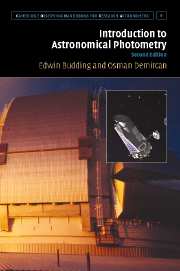Book contents
- Frontmatter
- Contents
- Preface to first edition
- Preface to second edition
- 1 Overview
- 2 Introduction
- 3 Underlying essentials
- 4 Themes of astronomical photometry
- 5 Practicalities
- 6 Procedures
- 7 Basic light curve analysis
- 8 Period changes in variable stars
- 9 Close binary systems
- 10 Spotted stars
- 11 Pulsating stars
- Appendix
- Author index
- Subject index
7 - Basic light curve analysis
Published online by Cambridge University Press: 13 August 2009
- Frontmatter
- Contents
- Preface to first edition
- Preface to second edition
- 1 Overview
- 2 Introduction
- 3 Underlying essentials
- 4 Themes of astronomical photometry
- 5 Practicalities
- 6 Procedures
- 7 Basic light curve analysis
- 8 Period changes in variable stars
- 9 Close binary systems
- 10 Spotted stars
- 11 Pulsating stars
- Appendix
- Author index
- Subject index
Summary
Light curve analysis: general outline
In this chapter we approach some classic problems of photometric analysis. We start with the light curves of eclipsing binary stars. These reduce, in their simplest form, to regular patterns of variation which can be understood by reference to relatively simple models of stars in a simple geometrical arrangement. First estimates for key parameters can often be directly made from inspection of the salient features of a light curve. This is a useful preliminary to more detailed analysis. The main issue underlying this and subsequent chapters, however, concerns the setting out of a comprehensive procedure for parameter value estimation. This represents a subsection of the field of optimization analysis, or the optimal curve-fitting problem.
In the version of this problem that faces us, we are given a set of N discrete observations lo (ti), i = 1, …, N, in a data space, which have a probabilistic relationship to an underlying physical variation, dependent in a single-valued way on time t. This real variation, whatever its form, is approximated by a fitting function, lc(aj, t), say, which is, formally, some function of the independent variable t, and a set of n parameters aj, j = 1, …, n. In general, we regard a subset m of these parameters as determinable from the data.
The object is to transfer the lo(ti) information from data space to the aj information in parameter space.
- Type
- Chapter
- Information
- Introduction to Astronomical Photometry , pp. 247 - 278Publisher: Cambridge University PressPrint publication year: 2007



